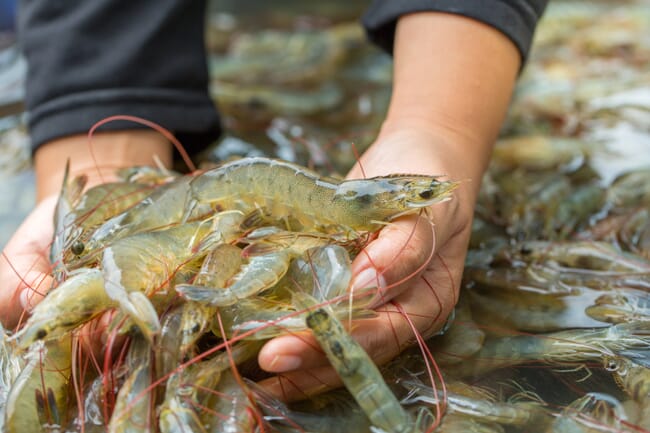
Though the shrimp sector has recently posted stunning growth, disease outbreaks remain a constant worry for producers
The shrimp industry is looking for new ways to combat outbreaks of white spot disease – especially since previous treatment strategies have relied on the prophylactic use of antibiotics and other chemical therapies. As shrimp producers try to curtail the use of these compounds to prevent the rise of drug-resistant microbes and harmful residues, the industry is turning to immunostimulants. These eco-friendly, antiviral compounds can shore up the immune systems of farmed shrimp – allowing them to ward off a broad spectrum of invading pathogens.
As the global industry recovers from pandemic-related setbacks, researchers are putting a spotlight on immunostimulants. If shrimp producers successfully deploy these compounds while maintaining farm biosecurity, the industry can decrease its reliance on antibiotics and keep white spot disease at bay.
The shrimp market in 2022
Though the shrimp industry faced significant setbacks from Covid-19 lockdowns and trade upsets in 2020, the $18.3-billion market* is expected to rebound and grow to $23.4 billion by 2026. Recent analysis from Rabobank has noted strong demand favourable market prices in the sector. Analysts expect the shrimp supplies in India and Ecuador to increase. If production costs remain steady, the sector’s growth trajectory will continue.
Moving beyond the broad sweeps of supply and demand, shrimp farming is influenced by two competing forces: technology and disease outbreaks. Historically, shrimp producers – who are usually based in developing countries – will gain a competitive advantage and grow by adopting novel technologies, only to have their advancement curtailed – or even erased – by diseases like white spot syndrome.
According to recent farm-level surveys from the Global Outlook for Aquaculture Leadership (GOAL), shrimp farmers listed disease outbreaks as their greatest production challenge. Feed costs, access to disease-free broodstock and fluctuating international market prices were the industry’s other top concerns. If shrimp farmers can find effective and environmentally sustainable ways to keep diseases at bay, the sector can focus on improving shrimp health and finishing quality. These improvements could translate into higher profit margins for producers.
White spot disease and existing treatment options
White spot disease is caused by the white spot syndrome virus (WSSV). White spot outbreaks are highly contagious and can be devastating, with some producers reporting entire shrimp crops being annihilated within three to seven days of infection.
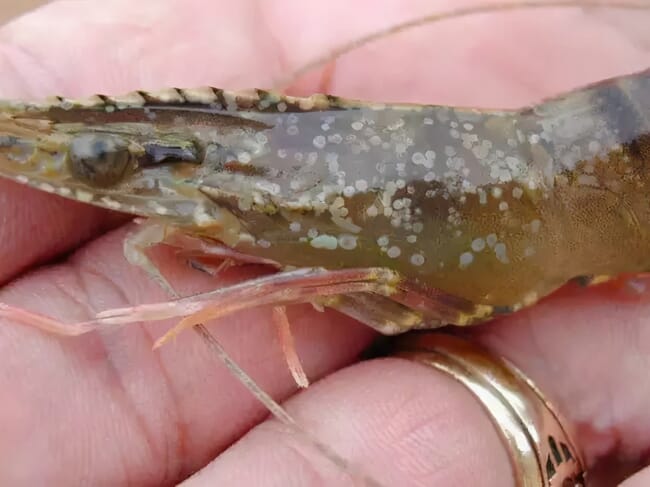
Other signs of the disease include lethargy, cessation of feeding and aggregations of moribund prawns near the water surface at the edge of the pond or tank © D Lightner
Currently, there aren’t any drug treatments for white spot disease – researchers have been unable to pinpoint the virus’s infection path in shrimp. The lack of viral genome data and scant information on how the pathogen interacts with host tissues have also kept researchers in the dark.
An additional challenge for researchers is rooted in shrimp biology. Shrimp, like other crustaceans and invertebrates, lack an adaptive immune system. Instead, they rely on their innate immune system – natural defence mechanisms and humoral responses – to ward off infections. This means that the shrimp will react to any pathogen as if it is their first interaction with it. It will not develop long-term antibodies that can recognise and thwart future infections. Because their immune response is so short-lived, developing effective vaccines is difficult. These data gaps and biological challenges can partially explain why the shrimp industry hasn’t been able to keep white spot disease at bay.
Because treatment options are limited, shrimp producers have opted for preventive strategies to ward of WSSV. Though vaccines aren’t a workable mitigation strategy for white spot (yet), the industry has trialled other antibiotics, chemotherapeutics and immunostimulants to combat WSSV.
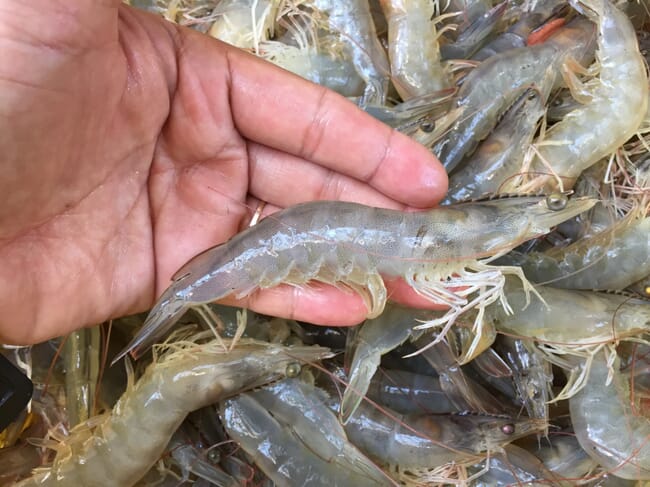
Shrimp lack an adaptive immune system. Instead, they rely on their innate immune system – natural defence mechanisms and humoral responses – to ward off infections
Why immunostimulants are standing out
Immunostimulants are naturally occurring substances that boost the defence machinery of host organisms. This boost wards off invading pathogens or parasites. They can be administered to shrimp both orally and by injection – with oral delivery via aquafeed gaining traction with shrimp producers. In 2013, researchers Barman and Nen found that immunostimulants were the most innovative way to combat shrimp diseases. That view is becoming more prominent as shrimp aquaculture expands.
Different immunostimulant molecules can compensate for the shortfalls in vaccines and chemotherapeutants. They also provide a similar disease resilience boost to antibiotics without courting the rise of antimicrobial resistance. Since trials have shown that these compounds are safer than chemotherapeutants and have a broader range of efficacy than vaccines, researchers have been learning how they can be used against white spot disease.
How immunostimulants work
If an immunostimulant molecule gets past a shrimp’s hard exoskeleton, it makes its way into the haemocoel, or main body cavity. Once it is there, the haemocytes of the shrimp’s innate immune system detect it as a foreign material. Since the innate immune system can distinguish “self-cells” that belong to the shrimp and “non-self” cells and materials, the immunostimulant initiates a chain of events that prime and reinforce the immune system. This “priming” creates a hostile environment for potential pathogens.
After this priming, if a pathogen is introduced to the haemocoel, the shrimp’s haemocytes – or blood cells – will aggressively attack it through phagocytosis, melanisation or encapsulation. Once the pathogen is killed, its debris concentrates in the gill and sinus tissues before it is expelled into the surrounding water.
Researchers believe that immunostimulants are effective because they jumpstart a shrimp’s immune responses when they are in the larval stage – just as innate immunity develops. The compounds are also useful because unlike adaptive immune antibodies or vaccine-induced immunity, immunostimulants trigger a general, or overall response that can detect and eliminate a wide spectrum of pathogens.
Reviewing the trial data
Immunostimulants can be divided into several groups depending on their origins and sources. A recent review by Kumar, Verma, Singh and Awasthi outlined seven broad categories of immunostimulants that can be used to prevent white spot infections in farmed shrimp.
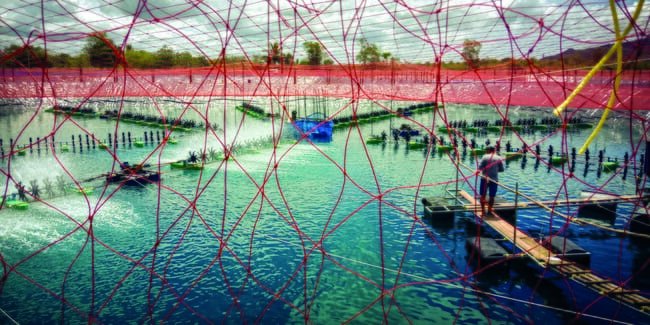
Different researchers have tested the efficacy of immunostimulant and antiviral compounds against white spot disease © FAI
Plant-derived and algae-derived immunostimulants
Plants – both terrestrial and aquatic – have a myriad of pharmaceutical, antimicrobial and immunostimulant properties. Plant-derived compounds can often be non-toxic, biodegradable and biocompatible with shrimp, putting them at the top of the list when new immunostimulant candidates have to be identified. Algae species also show potential as immunostimulants because they contain high concentrations of bioactive compounds.
- Recently, polysaccharides from ulvans, a type of green seaweed, have displayed immunostimulant properties when fed to shrimp.
- Fucodin – a bioactive compound found in Sargassum spp and Cladosiphon okamuranus seaweeds can stimulate defensive immune responses in shrimp and has given them some resistance to white spot disease.

Ulvans are a type of green seaweed and are rich in bioactive compounds © Ananda Arrieta
- Alginate obtained from brown seaweeds (U. pinnatifda and Lessonia nigricans) has boosted disease resistance in whiteleg shrimp.
- Genipin – a bioactive compound derived from the fruits of cape jasmine (Gardenia jasminiodes), slowed the replication of WSSV in the culture environment and decreased the viruses’ infectivity.
- Mangrove (Cereops tagal) extract and seagrass (Sargassum hemiphyllum var. chinensis) powder stimulated immune activity in whiteleg shrimp and tiger prawn, giving them enhanced defences against white spot disease.
- Herbal sources of lipopolysaccharides can boost immunity in shrimp and significantly reduce the viral load of white spot. These can be sourced from a broad family of herbs and include the plants:
- False daisy (Eclipta alba)
- Indian bael (Aegle marmelos)
- Heart-leaved moonseed (Tinospora cordifolia)
- Picrorhiza kurroa
- Scutch grass (Cynodon dactylon)
- Extracts from Argemone mexicana, a poppy species native to Mexico, the Western United States and India have antimicrobial and antioxidant properties that helped shore up survival rates of shrimp in WSSV challenge trials.
- Compounds from the leaves of the Pongame oiltree (Pongamia pinnata) can help increase the survival chances of WSSV-infected prawns and have other antiviral capacities.
- Polysaccharides extracted from durian (Durio zibethinus), a common fruit tree in Southeast Asia and Thailand, have a strong immunomodulatory effect when used as a feed additive for shrimp.
- Phytochemicals that contain coumarin and other polyphenols have shown promising antiviral results in lab trials.
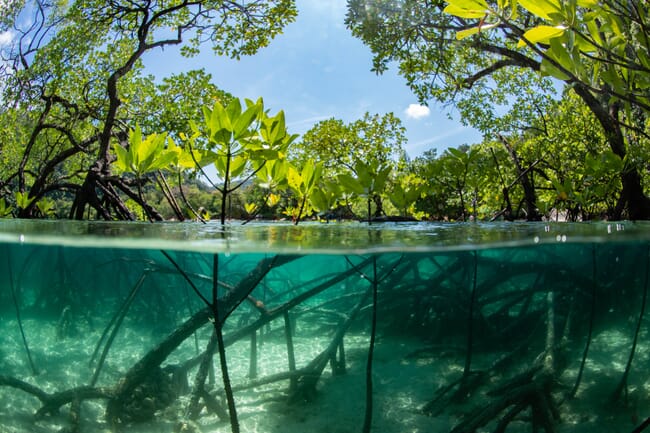
Mangrove extract can stimulate immune activity in whiteleg shrimp and tiger prawns
Immunostimulants from bacteria
Bacteria-derived immunostimulants have significant overlap with probiotics. They often come the bacillus family and provide a broad range of production benefits – and improving the immune competence of shrimp is one of them. Researchers have observed an immunostimulant effect against white spot syndrome from these bacteria and bacterial components:
- Orally inoculating shrimp with baculovirus and Bacillus subtilis spores helped strengthen immunity against white spot disease.
- Feeding different shrimp species a diet rich in peptidoglycan – a key component in the cell walls of some bacteria – helped boost immune responses like phagocytosis.
- Feeding farmed shrimp a diet containing lipopolysaccharides – a cell wall component of gram-negative bacteria – led to higher survival rates in disease challenge trials when compared to a control group.
- There is ample evidence that live probiotic bacteria can stimulate the immune systems of farmed shrimp species.
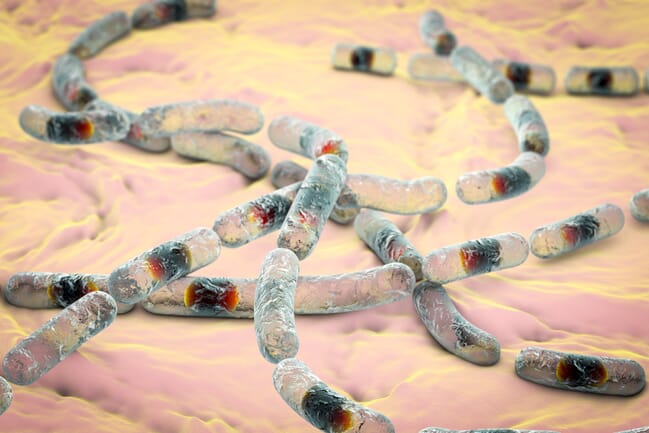
Using probiotics during the farm cycle has been linked with greater feed uptake, improved growth rates and greater disease resistance
Immunostimulants from fungi
Different marine and terrestrial yeasts act as both immunostimulants and probiotics. These compounds are often from the candida and saccharomyces genus and have demonstrated a wide range of nutritional and health benefits to crustaceans and other animals.
- Candida aquaetextoris S527, a marine yeast that can be included in aquaculture diets, was included in prawn diets after exposure to WSSV. Results from the trial showed that it acted as an immunostimulant and improved the prawns’ ability to survive the outbreak.
- Yeast extracts, often derived from Saccharomyces cerevisiae (bakers’ yeast), contain a variety of compounds that improve immune responses in shrimp and other fish.
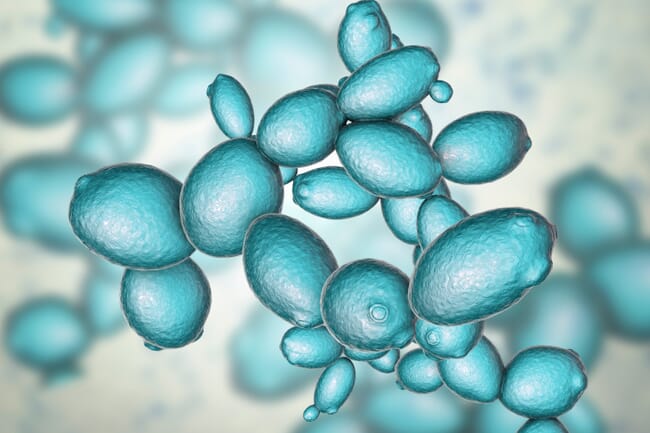
Saccharomyces cerevisiae (bakers’ yeast) has been used as a sustainable growth promoter in aquaculture
Synthetic immunostimulants
Researchers are beginning to explore the application of nanotechnology in biological systems. Since nanotechnologies can provide atomic-level details of their environments, nanoparticles can theoretically be used to combat viruses and track other biological compounds in the immune system. Silver nanoparticles (AgNPs) are currently gaining attention from researchers due to their antiviral properties and ability to stimulate immune responses.
The aquaculture industry is beginning to apply nanotechnology by creating AgNP-based formulations that can be injected in whiteleg shrimp. A study from 2020 found that single dosages of silver nanoparticles can boost shrimp survivability against a broad spectrum of pathogens (including WSSV) without causing toxic effects. Though this finding was promising, injecting individual shrimps with nanoparticles isn’t feasible. Researchers are hoping to develop a feed containing AgNPs that can provide the same immunostimulant effect.
Nutritional factors that boost immunity
Nutritional factors like vitamins, dietary carotenoids and trace elements like copper and zinc have been linked with improved immune function, greater resistance to stress and improved antioxidant responses in shrimp. Though immune improvements with vitamins A, C and E were observed when shrimp were injected with the supplements (making their application less feasible at the farm-level), oral zinc supplements were effective in other trials.
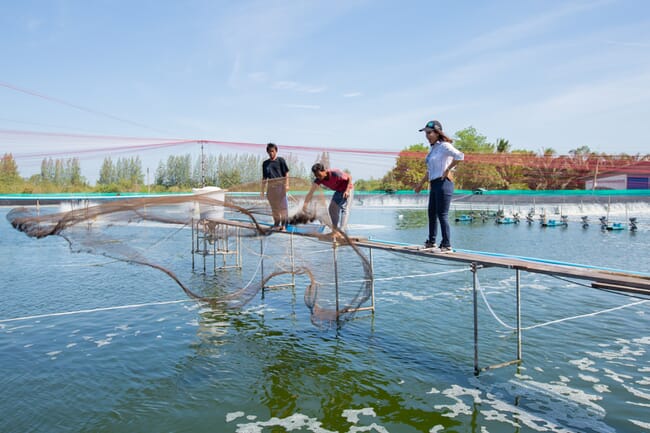
Nutritional factors like vitamins, dietary carotenoids and trace elements like copper and zinc have been linked with improved immune function © Quality Farms, Thailand
Immunostimulants from hormones
Growth hormone, also known as somatotropin or somatropin, has demonstrated multiple production benefits in aquaculture – including an increase in protein synthesis and immune responses. One trial that used recombinant bovine growth hormone in shrimp larvae found that the hormones enhanced the innate immune system and improved development. A different trial in giant prawns showed that supplementing diets with bovine lactoferrin (LF) improved immunological indices and boosted resistance to some bacterial infections.
Animal-derived immunostimulants
Researchers have been able to extract antiviral compounds from different animal species – from reptiles to insects – to combat white spot infections in shrimp. Promising animal-based immunostimulant compounds include:
- Cathelicidin 5, a peptide obtained from the Chinese alligator (Alligator sinensis), has demonstrated effective antimicrobial properties and gives some protection against WSSV in caridean shrimp (Exopalaemon modestus).
- Chitosans – derived from the polysaccharide chitin – is a key component in fungal cell walls and insect and crustacean exoskeletons. Both chitin and chitosan can protect fish and shrimp from bacterial infections when administered as a dietary supplement, through immersion or as an injection.
The importance of biosecurity
The researchers stress that banking on immunostimulants alone will not lead to success. Though trial data shows that they make shrimp crops more resistant to WSSV, using immunostimulants won’t make up for lapses in husbandry and sanitation. Shrimp producers need to maintain biosecurity protocols and procedures while they deploy immunostimulants for the best results.
The authors recommended completely emptying and drying shrimp ponds, using oxidising chemicals and disinfecting pond bottoms after each culture cycle. This will eliminate pathogens and potential vector organisms from the farm environment. Maintaining these protocols while supplementing shrimp diets with immunostimulants provides a “win-win” solution for shrimp producers and consumers. Farmers can keep diseases at bay and shoppers can enjoy better-quality and antibiotic-free shrimp.
Read the full review and bibliography in Environmental Science and Pollution Research.
*Market estimate based on data from 2020




